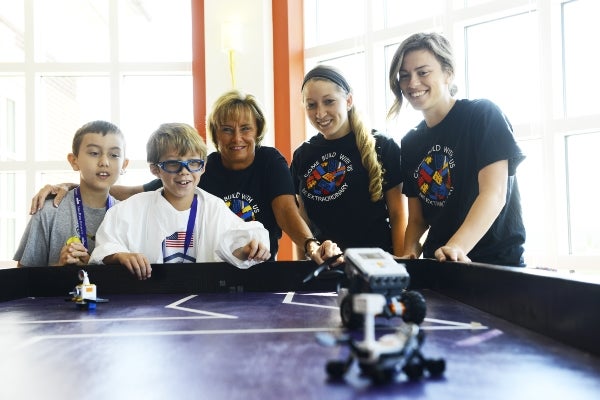Disseler finds passion for teaching in common children’s toy
Published 12:00 am Thursday, July 30, 2015

- Shirley Disseler watches as young students learn with Lego robots. Submitted photo
As a mom, Shirley Disseler’s relationship with Legos started early, but it didn’t end when her boys outgrew them. Instead of using them as toys now, she trains teachers how to use them as a valuable educational tool.
“There’s such a need for creativity in schools,” Disseler said, explaining why she loves using Legos in the classroom. “I see the engagement and the passion for learning come out in the kids.”
Disseler, a Salisbury resident, spent more than 20 years working in the Rowan-Salisbury School System as a teacher at Hurley Elementary and Southeast Middle and the middle grades curriculum facilitator for the district.
After receiving her doctorate in educational leadership with a focus in curriculum from the University of North Carolina at Charlotte, Disseler took a position as an associate professor for middle grades and elementary education at High Point University.
In 2011, Disseler was accepted to be a member of Lego Education’s advisory panel. She was the only one of 1,100 applicants selected. Her background in the classroom and curriculum development gave her a unique perspective on the products, which caught the attention of the folks at Lego.
“I knew an awful lot about curriculum,” she said.
So, she was asked to become a United States curriculum developer and lead trainer.
Because Lego is based in Denmark, Disseler helps tailor the curriculum for American academic standards.
“I help with their math curriculum,” she said. “Denmark does things flipped from the U.S. Their vocab, methodology is different.”
“That’s the fun part of it for me,” she added. “It is a unique process.”
“The key to Lego Education – the brick itself – is pretty universal,” she said.
Disseler, who has traveled all over the world with Lego Education, said it doesn’t matter where she teaches with Legos, her students’ “eyes just immediately light up.”
“It crosses over the cultural barrier,” she said.
Lego Education combines the actual brick with digitized activities for iPads and smartboards to create products that focus on literacy and STEM, or science, technology, engineering and math. The programs can work on anything from comprehension skills to robotics or simple machines.
“When a child learns in a classroom with a workbook and textbook, they’re using primarily the right side of the brain,” she said. “Lego adds connection between the right and left.”
She added that the learning theory involved in Lego learning is “very child-centered.”
“Kids need to learn with their hands, with their eyes and they also need to listen and talk with each other,” Disseler said, adding that building with Legos contributes to all three.
Disseler said Legos work especially well for Exceptional Children students, English as a Second Language students and students with anger issues.
In order to introduce Lego Education to other North Carolina teachers and schools, High Point University hosts events for both teachers and students to learn with Legos.
Lego Teacher Academy allows teachers to come one Saturday a month and learn about a different Lego Education product.
Come Build With Us is a free field trip for public schools where students participate in four Lego activities, tour campus and have lunch. The activities are taught by High Point University graduate students studying STEM education.
Between working at High Point University and at Lego Education, Disseler said, “It’s like having two full-time jobs.”
“I have had one day to myself this summer,” she added.
But Disseler’s passion for both makes all the work worthwhile.
“I don’t think of either of my jobs as jobs. They’re both very big hobbies to me,” she said. “I love working with pre-service teachers. Teaching is my passion.”
“I don’t think I could give up one for the other,” she said.
“I wish every educator could have the opportunity to go through and be a part of what I’ve been a part of,” she said.


